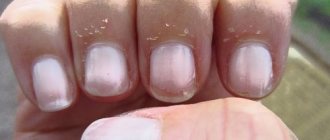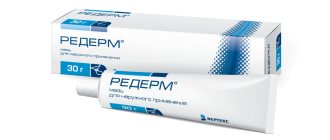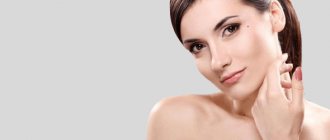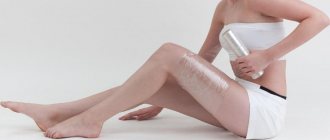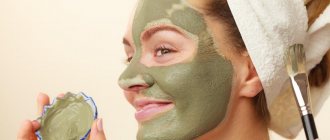Seborrhea develops in the so-called seborrheic zones - areas of the skin in which there are especially many sebaceous glands, about 400-600 per 1 cm2 1. These include:
- scalp;
- T-shaped area of the face (forehead, nasolabial folds, chin);
- the central part of the chest and the upper part of the back between the shoulder blades.
Seborrheic dermatitis is a chronic inflammatory disease that develops when the yeast-like fungus Malassezia furfur begins to actively multiply in the affected areas. About 3% of the population suffers from manifestations of this disease, and young people are more susceptible to them, among whom the number of patients increases to 5%.2
The disease is considered quite common. It manifests itself especially often in the first years of a child’s life, as well as in people after 40 years of age. This age-related feature of the occurrence of seborrheic dermatitis is explained by the fact that it is during these periods of a person’s life that the sebaceous glands on the body work with high intensity.
Causes of occurrence and development
The development of seborrhea and seborrheic dermatitis is based on dysfunction of the sebaceous glands of the skin, which manifests itself in the fact that the glands begin to produce either too little secretion (sebum) or too much, in addition, the composition and consistency of the secretion also changes. Excess secretions are mixed with dust, dead skin cells and can serve as a substrate for the active reproduction of opportunistic microorganisms, most often fungi of the genus Malassezia, which are normally present on the skin of 90% of the population3. The metabolic products of this pathogen cause skin irritation and its inflammatory reaction, manifested in the form of redness and the appearance of papules covered with greasy crusts.
Why does the functioning of the sebaceous glands malfunction? Doctors identify many factors that can play a role in dysfunction of the sebaceous glands. Among them:
- genetic predisposition;
- changes in hormonal levels (increased levels of progesterone and androgens, decreased levels of estrogen - therefore, the disorder is often found in men), including in infancy, puberty, pregnancy, and chronic diseases;
- decreased immunity due to chronic or infectious diseases, taking potent medications;
- a lot others.
The ducts of the sebaceous glands open into the mouth of the hair follicle, so with seborrhea and seborrheic dermatitis, not only the skin, but also the patient’s hair suffers.
The problem may worsen as a result of prolonged exposure to heat or due to increased sensitivity of the skin to external irritants. At the same time, seborrheic dermatitis in children and adults can be severe, regardless of the number of active fungi on the skin.
What contributes to the development of seborrhea?
Seborrheic dermatitis is difficult to treat with medications at home. Most often, the disease manifests itself when the immune system is weakened. Symptoms of seborrhea are caused by yeast fungi that secrete pathogenic enzymes and staphylococcus bacilli. They accumulate in the body and negatively affect health: hormonal disruptions occur and immune defense decreases. As a result, the production of sebaceous fat is disrupted, which leads to infections and inflammation. The development of seborrhea is promoted by: obesity, stress, alcohol, genetic predisposition.
How does seborrheic dermatitis manifest?
The disease affects certain parts of the human body. Typically this is:
- scalp skin;
- face;
- behind-the-ear areas;
- upper body (most often the area of the chest, shoulder blades);
- large skin folds on the body (for example, groin area, armpits).
Seborrheic dermatitis in adults and children manifests itself in the form of local redness and papules covered with greasy scales.
The disease can also be recognized at an early stage in adults by the appearance of a sign such as dandruff. As the situation worsens, the scalp gradually begins to become covered with red spots; later they can merge, forming lesions with characteristic peeling of the skin. In advanced cases, when oily crusts peel away from the surface of the skin, a moist secretion is discovered underneath. If you do not take any measures to treat seborrheic dermatitis, then this problem may be complicated by the addition of an infection.
In addition to external signs of seborrheic dermatitis, patients often complain of itchy skin. As a result of constant scratching of the inflammation, even greater tissue injury occurs with a high risk of further infection.
The disease not only causes serious discomfort, but also worsens a person’s quality of life as a whole, provokes self-doubt, makes it difficult to establish contacts with other people, and prevents them from building close relationships with the opposite sex.
How to get rid of dry seborrhea
Any doctor will tell you that dry seborrhea is not a death sentence. A comprehensive course of wellness therapy and many methods of effective treatment will help you quickly eliminate the disease. Ozone therapy, physiotherapy, and mesotherapy have performed well. Gymnastics, medicines and folk remedies are shown. Dermatitis in half of the cases is caused by other diseases that need to be treated urgently.
Shampoo for dry dandruff
Medicinal shampoo for dry seborrhea will help eliminate unpleasant symptoms and cure the disease. It will effectively remove dandruff and help cure dermatitis. The main thing is not to wash your hair often, but as indicated in the instructions. Shampoos for treatment are:
- With an antifungal agent - ketoconazole, bifonazole, terbinafine (Nizoral, Dermazol, Keto Plus, Ketozoral). Shampoos effectively prevent the proliferation of fungus, reduce its population, and as a result, the disease recedes.
- With zinc (Friderm Zinc, Cynovit, Zincon). This chemical element is an antiseptic and removes bacterial infection of the skin.
- With urea (Kelual DS, Vichy, Ducray). Urea is a natural emollient that effectively relieves itching and burning of the scalp.
- With sulfur (Sulsena). The line includes a preventative, therapeutic peeling shampoo that gently exfoliates dandruff and has a restorative effect on the scalp. Thanks to sulfur, it has an anti-inflammatory effect.
Shampoos can be prescribed in several names. The photo will help you avoid buying a fake. Your task is to alternate means, for example:
- A product with urea for daily use will help relieve itching.
- You use antifungal shampoo twice a week, it fights the cause of the disease.
Diet for dry seborrhea
Restoring the nutritional system in case of skin diseases is an important factor. The diet for dry seborrhea should exclude fatty, fried spicy foods from the diet. Eat more green vegetables and fruits rich in microelements. Suitable: different types of cabbage, apples, citrus fruits, leeks, salads. Do not forget about consuming protein necessary for the hair follicle: eggs, fish, lean meat, buckwheat. A nutritionist will help you create a nutritional system that will make your body healthy.
Symptoms and forms/Types of seborrheic dermatitis
If we consider seborrhea and seborrheic dermatitis in children and adults, we can distinguish the following varieties:
- Dry seborrhea. With this nature of the disease, the sebaceous glands produce an insufficient amount of secretion. As a result, the skin does not receive enough moisturizing components, dries out, and microcracks appear on its surface. Typically, dry seborrhea occurs without the formation of acute inflammatory foci. Instead, the patient is concerned about the separation of dry dandruff particles. Most often, this form of the disease is observed in adolescent children.
- Oily seborrhea. The form differs from the previous one in that the sebaceous glands, on the contrary, work too actively and secrete a large amount of thick secretion. The substance glues together dead skin cells and is deposited on the hair, causing it to take on an unkempt appearance. The problem often affects young women.
- Combined type. It is characterized by the presence of signs of both dry and oily seborrhea. The disease develops in various parts of the body and therefore causes serious discomfort. In most cases, this form is diagnosed in males.
Depending on the location of the foci of inflammation, seborrheic dermatitis of the scalp, face and torso is distinguished.
The first sign of damage to the scalp is the appearance of dandruff. In this case, the scalp can be either excessively dry or oily, and the scales can range from silvery-white in mild cases to dense fatty crusts in severe cases.
In patients with seborrheic dermatitis of the scalp, over time, the hair becomes sparse, thin, brittle and often falls out.
Focal inflammation on the face is considered no less common. This form of the disease mainly affects teenagers and young people under the age of 25. The cause of seborrheic dermatitis in this case is the high activity of the sebaceous glands in the facial area. During puberty, they begin to work more actively, which can provoke the development of the disease. On the face, rashes are often symmetrical, located in the forehead, nasolabial folds, wings of the nose, and eyebrows.
At the initial stage, the disease manifests itself in limited areas of inflammation, the surface of which is covered with white-yellow scales. The rash is accompanied by itching and constantly peels off. As the disease progresses, areas of inflammation may merge. In some cases, inflammation is aggravated by the addition of a secondary infection.
Sometimes the inflammation spreads to the skin of the eyelids. This leads to the development of seborrheic blepharitis. It is characterized by the formation of severe swelling of the eyelids, redness of the eyes, and the formation of cracks in the delicate skin in this area. At the eyelash growth line, inflammatory foci gradually begin to form with a characteristic separation of small scales and crusts. Because of this, patients have to literally “pry” their eyes out in the morning, since the eyelids stick together so much.
On the torso, seborrheic dermatitis is usually localized in the area of the sternum and shoulder blades. The disease occurs with the formation of foci of inflammation with clear boundaries, covered with yellowish scales.
The severity of seborrheic dermatitis varies from mild to severe and depends on the extent of skin lesions, severity of inflammation and intensity of itching.
Infantile seborrheic dermatitis is one of the first skin diseases that a child encounters. It develops against the background of immature functions of the skin and sebaceous glands in infants and manifests itself in the form of fatty yellow crusts covering the head (the so-called “baby cap”), sometimes the area of the eyebrows and cheeks.
Oily seborrhea
If too much sebum is produced, this can also lead to dandruff. The fact is that the secretion does not contain enough antibacterial substances. Favorable conditions are created for an increase in fungal colonies. The active activity of Malassezia leads to detachment of the epidermis and the appearance of oily dandruff.
Symptoms of oily seborrhea:
- greasy hair;
- itching;
- The scales stick together and peel off very poorly.
Oily seborrhea is often accompanied by acne and furunculosis. The skin of the scalp becomes crusty; scratching during itching leads to bloody wounds. If adequate treatment is not carried out, hair will begin to fall out.
Seborrhea, associated with increased sebum production, occurs not only on the scalp. It also appears on the face, especially in the area of the nasolabial triangle, behind the ears and on the chin. On the face, the disease is characterized by enlarged pores and graying of the skin.
The most common cause of oily seborrhea is hormonal imbalances. The disease often plagues adolescents during puberty. Most often, young men suffer, because it is male hormones that provoke the activity of the sebaceous glands.
Normally, seborrhea is temporary; by the age of 25, it goes away in most people. In 10% of cases the disease becomes chronic.
Another common cause of oily seborrhea is genetics.
Also, the impetus for the disease can be:
- frequent stress;
- deviations in the functioning of the nervous system;
- taking hormones;
- problems with the gastrointestinal tract;
- diseases of the genitourinary system.
Treatment of seborrheic dermatitis: basic approaches and methods
The tactics and treatment regimen for seborrheic skin dermatitis are selected by the doctor based on the form in which the disease occurs and in which area the inflammation is localized.
If the disease is mild, then this form is characterized by the presence of a small amount of dry or greasy scales, moderate redness of the skin, and occasional mild itching. With this course of the disease, the doctor, as a rule, limits himself to external therapy. For example, with mild damage to the scalp, or dandruff, the doctor may recommend the use of Skin-cap shampoo. Apply shampoo to damp hair, then massage the scalp until foam forms and rinse thoroughly. After this, you need to reapply the shampoo, leave for 5 minutes, and rinse thoroughly with plenty of water. Skin-cap shampoo can be used both for exacerbation of seborrheic dermatitis according to the scheme 2-3 times a week, and for the prevention of further relapses 1-2 times a week.
When the disease occurs in moderate to severe form, the symptoms of seborrheic dermatitis become more pronounced. At this stage, brighter red spots appear on the skin, sometimes noticeable swelling forms on the skin, and the surface is covered with dense gray-yellow crusts. All this occurs against the background of severe itching, which is present almost constantly. Due to discomfort, the patient cannot work fully, it is difficult for him to concentrate on anything, and often in the acute phase of the disease a person experiences problems with sleep.
In this case, there are also generally accepted recommendations on how to treat seborrheic dermatitis. The measures taken are comprehensive; patients may be prescribed hormonal medications. Treatment of seborrheic dermatitis is prescribed by a doctor, based on the severity of the disease and the individual characteristics of the patient. One of the non-hormonal drugs for the treatment of seborrheic dermatitis is the drug Skin-cap. It inhibits the activity of the Malassezia fungus and helps reduce signs of inflammation and also helps reduce flaking. Depending on the location of the inflammatory foci, Skin-cap shampoo, cream or aerosol may be prescribed. Skin-cap aerosol, for example, is suitable for treating the scalp, and the cream is convenient to apply to the face. The duration of treatment for an exacerbation varies, usually it takes from two weeks to 1 month to completely eliminate the symptoms of the disease.
The use of shampoo, cream and aerosol Skin-cap helps to significantly alleviate the condition of seborrheic dermatitis. The active ingredient of the drug Skin-cap has the following effects:
- provides anti-inflammatory effect;
- suppresses the growth and reproduction of pathogenic fungi, which are the main cause of exacerbation of the disease;
- inhibits the activity of bacteria that can increase inflammation.
The drug can be recommended to patients with any form of seborrheic dermatitis; treatment is possible for both adults and children over the age of one year. Products from the Skin-Cap line do not just eliminate the signs of the disease, they help keep the disease under control, preventing relapses.
Folk remedies
Antifungal ointments for seborrheic dermatitis can be made at home. Recipes often use essential oils, herbal decoctions and birch tar - these components have a good antiseborrheic effect. Seborrhea lotion is infused with herbs and rubbed over inflamed and weeping areas of the skin.
Tar soap for seborrheic dermatitis turns out to be a good antifungal agent. Sea salt and aloe have an effective effect against seborrhea. It is recommended to combine folk remedies with taking tablets against seborrheic dermatitis.
Recipe : apple cider vinegar 9% (1.5 ml.) mixed with camphor alcohol (5 ml.), salicylic alcohol 2% (15 ml.), dimexide (10 ml.), trichopolum (1.5 g.); resorcinol (0.25g); sodium tetraborate (2g); potassium permanganate (25 ml.), and purified water (50 ml.) is added. The mixture is thoroughly mixed and rubbed into the hair roots. Do not rinse for 20 minutes. When applying, be sure to protect your hands with rubber gloves.
Features of SKIN-CAP release forms
The cream is quickly absorbed and softens and moisturizes the skin well and does not leave greasy marks on it. It is suitable for facial skin and affected surfaces that require moisturization.
The aerosol can be applied even to the scalp using a special nozzle, which is included in the kit, without touching the hair. It helps eliminate itching and dries out wet rashes.
Seborrhea shampoo effectively7 fights its manifestations on the scalp. Actively helps eliminate dandruff and itching, fights the root cause of the disease - pathogenic microorganisms. Ideal for preventing relapses.
Skin-cap shower gel is a cosmetic product that is indispensable for daily hygiene in cases where seborrhea affects the skin of the chest and back. It cleanses, soothes and moisturizes the skin, helps eliminate inflammation and restores the protective properties of the skin.
Drug treatment
In addition to the medications listed below, you should follow a strict diet. Recommended drugs:
- antifungals (Ketonazole, Bifonazole, Lamisil);
- vitamins (Hexavit, Multitabs);
- preparations based on herbal components;
- antihistamines (Loratadine, Cetirizine).
Medication therapy lasts 1–2 months. Once every six months it is necessary to carry out a preventive course of treatment.
Shampoos
To choose the right shampoo, you need to diagnose the type of skin disease: oily, dry, mixed seborrhea, with thick or thin secretion. Based on this, shampoo is selected:
- with an antifungal effect, containing ketoconazole;
- with antibacterial properties, contains zinc pyrithione;
- with exfoliating effect, based on salicylic acid;
- a product containing tar.
Having made a choice, you need to wash your hair with shampoo for three months, then use it once every half month for prevention. After washing your hair, it is recommended to make an oil-based hair mask at night.
Use of ointments
If you need to treat seborrhea of the scalp at home in children or adults, then ointments are often prescribed for the dry form. The most effective is regular sulfur ointment 10%. To rub it in correctly, you need to follow the direction of the parting. The course of treatment lasts 8 days, and the next day you need to give your head a break. On the 10th day, wash your hair with boiled water and special shampoos with the addition of selenium, tar, and zinc.
On the 11th day after rubbing in the ointment, begin treating the scalp using a solution of boric acid. The solution is made with 150 ml of boiling water, in which a large spoonful of boric acid is dissolved. Apply at night, wrap hair with a towel. Carry out the procedure for three days, then take a break for 7 days. This course of treatment can be repeated, at weekly intervals, up to three times.
Prevention of seborrheic dermatitis
Patients with this disease need to know not only how to treat seborrheic dermatitis, but also learn the basic rules for preventing exacerbation of the disease. The main task in this case is to exclude those factors that can trigger the triggering of pathology development mechanisms.
Thus, as part of the prevention of seborrheic dermatitis, it is worth paying attention to several aspects:
- following a certain diet;
- compliance with personal hygiene rules;
- quality skin care;
- maintaining an active and healthy lifestyle;
- timely treatment of concomitant diseases.
General principles of treatment
In complex cases of seborrheic dermatitis, doctors prescribe medications to improve digestion and improve metabolism. Therapy often also includes vitamins, minerals, and hormonal pills.
Depending on your medical history, your doctor may prescribe hair growth activators. For oily seborrhea, drying shampoos containing tar, sulfur or salicylic acid are used.
A specialist may prescribe the use of balms with moisturizing and nutritional components - amino acids, keratin, protein.
There are two main groups of care products that can stop hair loss due to seborrhea:
- stopping the formation of dandruff;
- stimulating hair growth.
The first includes antifungal shampoos, lotions, and scrubs. It is important to use them in accordance with the instructions. The second group includes herbal tinctures, masks, and oils for rubbing into the scalp. Their task is to strengthen hair and stimulate growth.
Diet for dermatitis
The diet for seborrheic dermatitis should be based on healthy foods containing a small amount of fat. These include a variety of cereals, lean meats and fish, and always fresh vegetables and fruits.
It is important not only to eat well and properly, but also to follow some recommendations for cooking. Thus, the most preferred options for heat treatment of products are boiling, baking, steaming or grilling without adding oil.
Maintaining personal hygiene
Patients with seborrheic dermatitis are recommended to injure the inflammation as little as possible. Personal hygiene rules include cleansing the skin twice a day using special products with a low pH. To cleanse the skin, it is prohibited to use aggressive agents such as laundry or tar soap.
General recommendations for maintaining personal hygiene:
- the use of washcloths or sponges with hard fibers is excluded;
- For a while, you should avoid cleansing your skin with scrubs and peels containing abrasive particles and aggressive chemical compounds;
- During water procedures, it is recommended to use dechlorinated water; for this purpose, it is recommended to first settle or filter it;
- the duration of water procedures should be reduced to 10-15 minutes;
- when choosing shower products, choose products without dyes and fragrances, with a low pH;
- use towels with soft bristles, and it is better to blot your skin with them rather than rub them;
- to reduce the likelihood of skin injury when combing, try to cut your nails as short as possible;
- Avoid using other people's personal hygiene items.
Healing oils
Oil therapy can be used for hair loss only after consultation with a specialist. Also, you should not choose masks for home preparation on your own if you are not sure that the composition will not harm hair weakened by seborrhea.
When treating alopecia, rose, flaxseed, lavender and castor oils may be recommended. They can be mixed with decoctions or herbal infusions and rubbed into the scalp. Lotions are made with oils and alcohol tinctures to help eliminate itching and redness.
In the presence of ulcers, oil wraps often help, as they restore metabolic processes in the scalp and hair follicles. Foci of inflammation, for example, are treated with oil solutions of vitamins A and E.
Skin care rules
Skin care prone to symptoms of seborrheic dermatitis is primarily focused on normalizing the functions of the sebaceous glands. It is important not only to reduce sebum production, but also to ensure skin hydration.
General care recommendations:
- Try to reduce the use of comedogenic makeup, as it can cause clogged pores.
- Use care products that do not contain alcohol. It irritates the skin, dries it out, causing the sebaceous glands to work more actively.
- For care, choose special cosmetic products designed for seborrheic skin.
Procedure in a beauty salon
Medical and cosmetology services for hair care are offered in our beauty salons. The masters will improve the condition of the curls and also prevent their loss. Growth stimulation is achieved through darsonvalization. Microcurrents during the treatment of the scalp affect cell membranes, which in turn triggers metabolic processes and normalizes the condition of the hair.
Mesotherapy helps normalize the functioning of the sebaceous glands and provide sufficient nutrition to the hair follicles. The combination of introduced cocktails is selected according to specific needs. The injections are not accompanied by pain and do not cause side effects. Hair problems are not a reason to be upset, this is a reason to turn to the professionals of the Apriori salons. Here you will be offered a prompt and effective solution, selected individually for each patient.


